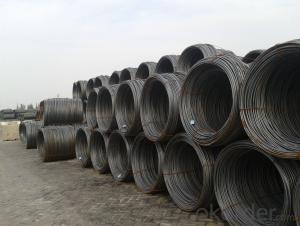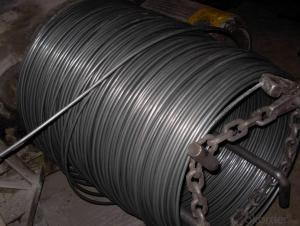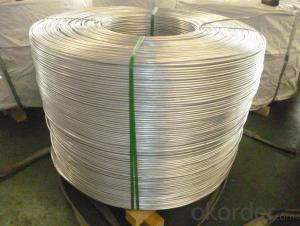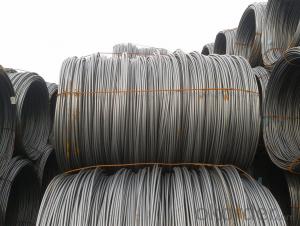SAE1006Cr Carbon Steel Wire Rod 14.5mm for Welding
- Loading Port:
- Shanghai
- Payment Terms:
- TT OR LC
- Min Order Qty:
- 100 m.t
- Supply Capability:
- 30000 m.t/month
OKorder Service Pledge
OKorder Financial Service
You Might Also Like
Item specifice
Description of SAE1006Cr Carbon Steel Wire Rod 14.5mm for Welding:
OKorder is offering Color Coated Steel Coil Prepainted Steel Coil at great prices with worldwide shipping. Our supplier is a world-class manufacturer of steel, with our products utilized the world over. OKorder annually supplies products to European, North American and Asian markets. We provide quotations within 24 hours of receiving an inquiry and guarantee competitive prices.
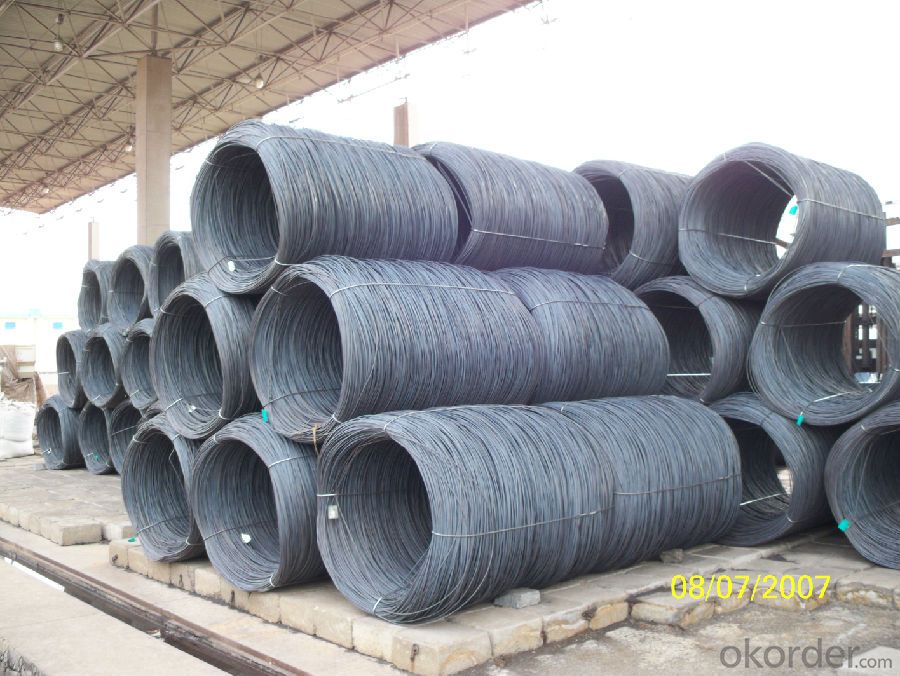
Applications of SAE1006Cr Carbon Steel Wire Rod 14.5mm for Welding:
Color Coated Steel Coil Prepainted Steel Coil are ideal for structural applications and are widely used in the construction of buildings and bridges, and the manufacturing, petrochemical, and transportation industries.
Main Product Features of SAE1006Cr Carbon Steel Wire Rod 14.5mm for Welding:
· Premium quality
· Prompt delivery & seaworthy packing (30 days after receiving deposit)
· Corrosion resistance
· Can be recycled and reused
· Mill test certification
· Professional Service
· Competitive pricing
Specifications of SAE1006Cr Carbon Steel Wire Rod 14.5mm for Welding:
1, Introduction: Color coated steel coils(sheets), i. E. PPGI, also called prepainted steel coils(sheets), are made of galvanized steel coils(sheets) with polymer coatings as surface. It's a new enclosure material and building board with characteristics of light-weighted, heat preserved&insulated, easily installed with bright colors.
2, Production Process: Pretreatment(Degreasing)_Drying_Chromating_Paint Basic Oil_Cooling_Drying_Color Coating_Cooling_Film-covering_Rolling Up
3, Characteristics:
Good at corrosion resistence. Besides zinc coating of the basic plate of galvanized steel sheet, the color coating as the surface has double lifetime to ensure better anticorrosion effect.
With excellent cold bending molded manufacturablity, PPGI products can be processed or directly used as final product. As being light-weighted and conveniently transported, they're widly used to replace wood to save energy.
4.There're thousands of colors can be chosen as per different application. Any color plays well in decoration.
No pollution with high recycling rate, PPGI coils and sheets are strongly recommended as enviroment-friendly products by the government.
5, eye bands and 4 circumferential bands in steel, galvanized metal fluted rings on inner and outer edges, galvanized.
| commodity | SAE1006Cr Carbon Steel Wire Rod 14.5mm for Welding |
| Techinical Standard: | JIS G3302-1998, EN10142/10137, ASTM A755 |
| grade | Q195,Q215,Q235,SAE1006,SAE1008 SAE1006Cr |
| Types: | Mesh welding |
| Base metal | galvanized, galvalume, cold rolled steel |
| Thickness | 0.14-1.0mm(0.16-0.8mm is the most advantage thickness) |
| Width | 610/724/820/914/1000/1200/1219/1220/1250mm |
| Type of coating: | PE, SMP, PVDF |
| Zinc coating | Z60-150g/m2 or AZ40-100g/m2 |
| Top painting: | 5 mic. Primer + 15 mc. R. M. P. |
| Back painting: | 5-7 mic. EP |
| Color: | According to RAL standard |
| ID coil | 508mm610mm |
| Coil weight: | 2--3MT |
| Package: | Properly packed for ocean freight exportation in 20'containers |
| Application: | Industrial panels, roofing and siding for painting/automobile |
| Price terms | FOB, CFR, CIF |
| Payment terms | 20%TT in advance+80% TT or irrevocable 80%L/C at sight |
| delivery time | 25 days after recepit of 20% TT |
| Remarks | Insurance is all risks |
| MTC 3.1 will be handed on with shipping documents | |
| We accept SGS certificatation test |
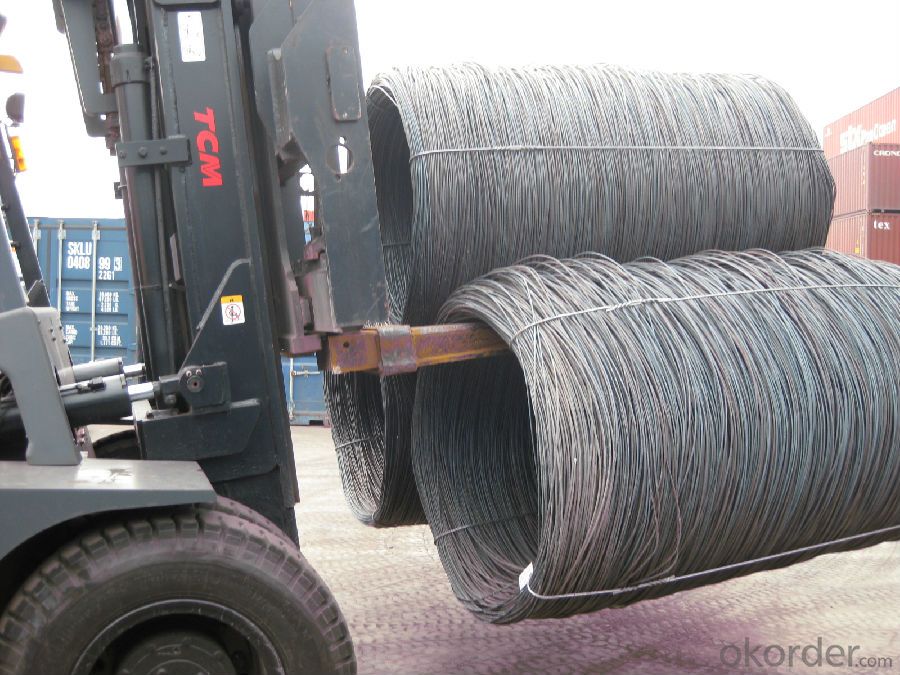
FAQ of SAE1006Cr Carbon Steel Wire Rod 14.5mm for Welding:
Q1: Why buy Materials & Equipment from OKorder.com?
A1: All products offered byOKorder.com are carefully selected from China's most reliable manufacturing enterprises. Through its ISO certifications, OKorder.com adheres to the highest standards and a commitment to supply chain safety and customer satisfaction.
Q2: How do we guarantee the quality of our products?
A2: We have established an advanced quality management system which conducts strict quality tests at every step, from raw materials to the final product. At the same time, we provide extensive follow-up service assurances as required.
Q3: How soon can we receive the product after purchase?
A3: Within three days of placing an order, we will begin production. The specific shipping date is dependent upon international and government factors, but is typically 7 to 10 workdays.
Q4: What makes stainless steel stainless?
A4: Stainless steel must contain at least 10.5 % chromium. It is this element that reacts with the oxygen in the air to form a complex chrome-oxide surface layer that is invisible but strong enough to prevent further oxygen from "staining" (rusting) the surface. Higher levels of chromium and the addition of other alloying elements such as nickel and molybdenum enhance this surface layer and improve the corrosion resistance of the stainless material.
Q5: Can stainless steel rust?
A5: Stainless does not "rust" as you think of regular steel rusting with a red oxide on the surface that flakes off. If you see red rust it is probably due to some iron particles that have contaminated the surface of the stainless steel and it is these iron particles that are rusting. Look at the source of the rusting and see if you can remove it from the surface.
- Q:How is steel wire rod tested for flexural strength?
- Steel wire rod is typically tested for flexural strength using a three-point bending test. In this test, the rod is supported on two points while a force is applied at the center of the rod. The amount of force required to cause the rod to bend and ultimately fracture is measured, providing an indication of its flexural strength.
- Q:How is steel wire rod used in the production of wire for musical instruments?
- Steel wire rod is an essential component in the production of wire used for musical instruments. It serves as the raw material that undergoes various manufacturing processes to transform it into the desired wire form. Firstly, the steel wire rod serves as the starting point for creating different gauges of wire required for different musical instruments. It is typically made from high-quality steel with specific chemical compositions and mechanical properties that ensure the desired strength and durability of the final wire product. Once the steel wire rod is obtained, it undergoes a series of processes such as drawing, annealing, and tempering to achieve the desired characteristics. Drawing involves pulling the wire rod through a series of dies to reduce its diameter and increase its length. This process helps in refining the wire's surface finish and improving its tensile strength. Annealing is another crucial step that involves heating the wire to a specific temperature and then slowly cooling it. This process helps to relieve internal stresses, improve the wire's ductility, and enhance its ability to resonate when used in musical instruments. After annealing, the wire may undergo further processes like tempering, which involves heating the wire to a lower temperature and then cooling it rapidly to achieve specific hardness and springiness. This step is crucial in creating wire with the desired flexibility and responsiveness required for various musical instruments. Once the wire is produced, it can be used in the construction of different musical instruments. For example, steel wire is commonly used in the production of guitar strings, piano wires, and various brass instruments. The specific gauge and composition of the wire are carefully selected to produce the desired pitch, tonal quality, and playability of the instrument. In conclusion, steel wire rod plays a vital role in the production of wire for musical instruments. It serves as the raw material that undergoes various manufacturing processes to create wires of different gauges, strengths, and tonal characteristics. These wires are then used in the construction of various musical instruments, contributing to the creation of beautiful sounds and melodies.
- Q:What is the difference between a wire rod and a straight bar?
- Wire rod refers to the delivery of goods in the form of plate delivery, usually with a finer steel, diameter less than 12. When used to straighten, has the advantages of convenient transportation, storage, basically no waste material
- Q:What are the common production processes for nitrogen-coated steel wire rod?
- The common production processes for nitrogen-coated steel wire rod typically include wire drawing, cleaning, coating with nitrogen, and annealing. The wire drawing process involves reducing the diameter of the wire rod through a series of dies. After wire drawing, the wire rod is cleaned to remove any impurities. Next, a nitrogen coating is applied to the wire rod to enhance its corrosion resistance and mechanical properties. Finally, the coated wire rod is annealed to relieve internal stresses and further improve its strength and flexibility.
- Q:How is steel wire rod priced in the market?
- Various factors influence the pricing of steel wire rod in the market. These factors encompass the production and demand aspects. The cost of raw materials, such as iron ore and scrap metal, as well as the expenses associated with energy and labor during the manufacturing process, contribute to the pricing. Furthermore, the price of steel wire rod is influenced by market conditions, supply and demand dynamics, and additional factors. Global economic conditions, trade policies, and infrastructure development projects are some of the elements that can affect the demand for steel wire rod, thereby impacting its price. Steel wire rod is commonly traded on commodity exchanges, where participants engage in buying and selling contracts based on future delivery dates. The price of steel wire rod on these exchanges is influenced by market speculation, storage costs, and transportation expenses. Moreover, the price of steel wire rod is determined by its quality and specifications. Different grades, sizes, and coatings of steel wire rod have varying prices based on their suitability for diverse applications and industries. In conclusion, the pricing of steel wire rod is determined by a combination of factors, including raw material costs, production expenses, market conditions, supply and demand dynamics, quality specifications, and trading activities on commodity exchanges.
- Q:How are steel wire rods used in the manufacturing of wire brushes for cleaning purposes?
- Wire brushes for cleaning purposes require steel wire rods as an essential component. These rods are typically crafted from high-quality steel, renowned for its strength, durability, and flexibility. To produce wire brushes, the steel wire rods undergo a series of procedures. Initially, the wire rods are carefully chosen based on their composition and tensile strength. Next, they are fed through a wire drawing machine, which reduces their diameter and elongates their length. This process allows for the creation of slender and lengthy wires, perfect for brush bristles. Once the wires are drawn, they are straightened and cut to the desired length, which may vary depending on the brush type. The straightened wires are then either inserted into a metal ferrule or twisted together to form a bundle, depending on the brush design. The wire bristles are subsequently affixed to a handle or base, which can be crafted from wood, plastic, or metal. This assembly procedure can be performed manually or with the assistance of specialized machinery. The bristles are securely fastened to prevent them from coming loose during use. Steel wire rods are favored for manufacturing wire brushes due to their outstanding cleaning properties. The strength and flexibility of steel enable the bristles to effectively eliminate dirt, grime, and debris from various surfaces. They are suitable for use on a wide range of materials, including metal, wood, and concrete. Wire brushes made from steel wire rods are commonly employed for cleaning tasks such as rust removal, paint stripping, and corrosion elimination from surfaces. They are also utilized in preparing surfaces for painting or welding, cleaning welding joints, and scrubbing hard-to-reach areas. These brushes find applications in industries like automotive, manufacturing, construction, and maintenance. To summarize, steel wire rods are vital in the production of wire brushes for cleaning purposes. Their strength, durability, and flexibility make them ideal for crafting efficient and dependable cleaning tools. Whether it involves rust removal, weld cleaning, or surface scrubbing, wire brushes made from steel wire rods are indispensable in numerous industries and households.
- Q:How is steel wire rod used in the manufacturing of wire rope clamps?
- Steel wire rod is used in the manufacturing of wire rope clamps as it serves as the raw material for creating the clamps' sturdy and durable structure. The steel wire rod is typically formed, shaped, and manipulated into the desired clamp design, providing the necessary strength and reliability to secure the wire rope in place.
- Q:How is steel wire rod used in the manufacturing of suspension bridges?
- The manufacturing of suspension bridges heavily relies on steel wire rod, which is an essential component. These bridges mainly utilize it in constructing the main cables, which bear the most critical load. The main cables, responsible for supporting the weight of the bridge deck and transferring the load to the towers or piers, rely on the steel wire rod. To form the main cables, the steel wire rod is initially shaped into separate strands. The number of wires per strand varies depending on the bridge's size and load capacity, ranging from hundreds to thousands. These strands are then tightly wound around a central core. The strength and durability of the steel wire rod make it an ideal material for this purpose since it can withstand the immense tension and load placed on the bridge. Aside from the main cables, steel wire rod may also be utilized in other parts of suspension bridges, such as the hangers and suspenders. These elements connect the bridge deck to the main cables and aid in evenly distributing the load throughout the structure. Steel wire rod is selected for these applications due to its high tensile strength, excellent flexibility, and resistance to corrosion. Overall, steel wire rod plays a pivotal role in the manufacturing of suspension bridges. It provides the necessary strength, durability, and flexibility to support the structure and ensure its safe and efficient operation.
- Q:How is the bending properties of steel wire rod tested?
- Steel wire rod's bending properties are usually assessed using a technique known as the bend test. During this examination, a wire rod sample is manipulated to a specific angle or curvature, and subsequently checked for signs of cracking or breakage. To conduct the test, one end of the wire rod is secured, while force is applied to the other end to facilitate bending. The force required to achieve the desired bend is measured, and the wire rod is visually inspected for indications of deformation or fracture. Additionally, the test may include measuring the wire rod's diameter prior to and after bending, in order to evaluate any alterations in its physical characteristics. By offering valuable insights into the flexibility and ductility of the steel wire rod, the bend test plays a crucial role in determining its suitability for various applications.
- Q:How is steel wire rod used in the manufacturing of wire for high-speed trains?
- Steel wire rod is used in the manufacturing of wire for high-speed trains because of its strength, durability, and ability to withstand high tension. The steel wire rod is first processed through a series of drawing and annealing processes to achieve the desired size and mechanical properties. This wire is then used to manufacture various components of the high-speed train, including electrical wiring, traction wires, and suspension cables, ensuring safe and reliable operation at high speeds.
1. Manufacturer Overview |
|
|---|---|
| Location | |
| Year Established | |
| Annual Output Value | |
| Main Markets | |
| Company Certifications | |
2. Manufacturer Certificates |
|
|---|---|
| a) Certification Name | |
| Range | |
| Reference | |
| Validity Period | |
3. Manufacturer Capability |
|
|---|---|
| a)Trade Capacity | |
| Nearest Port | |
| Export Percentage | |
| No.of Employees in Trade Department | |
| Language Spoken: | |
| b)Factory Information | |
| Factory Size: | |
| No. of Production Lines | |
| Contract Manufacturing | |
| Product Price Range | |
Send your message to us
SAE1006Cr Carbon Steel Wire Rod 14.5mm for Welding
- Loading Port:
- Shanghai
- Payment Terms:
- TT OR LC
- Min Order Qty:
- 100 m.t
- Supply Capability:
- 30000 m.t/month
OKorder Service Pledge
OKorder Financial Service
Similar products
New products
Hot products
Related keywords
